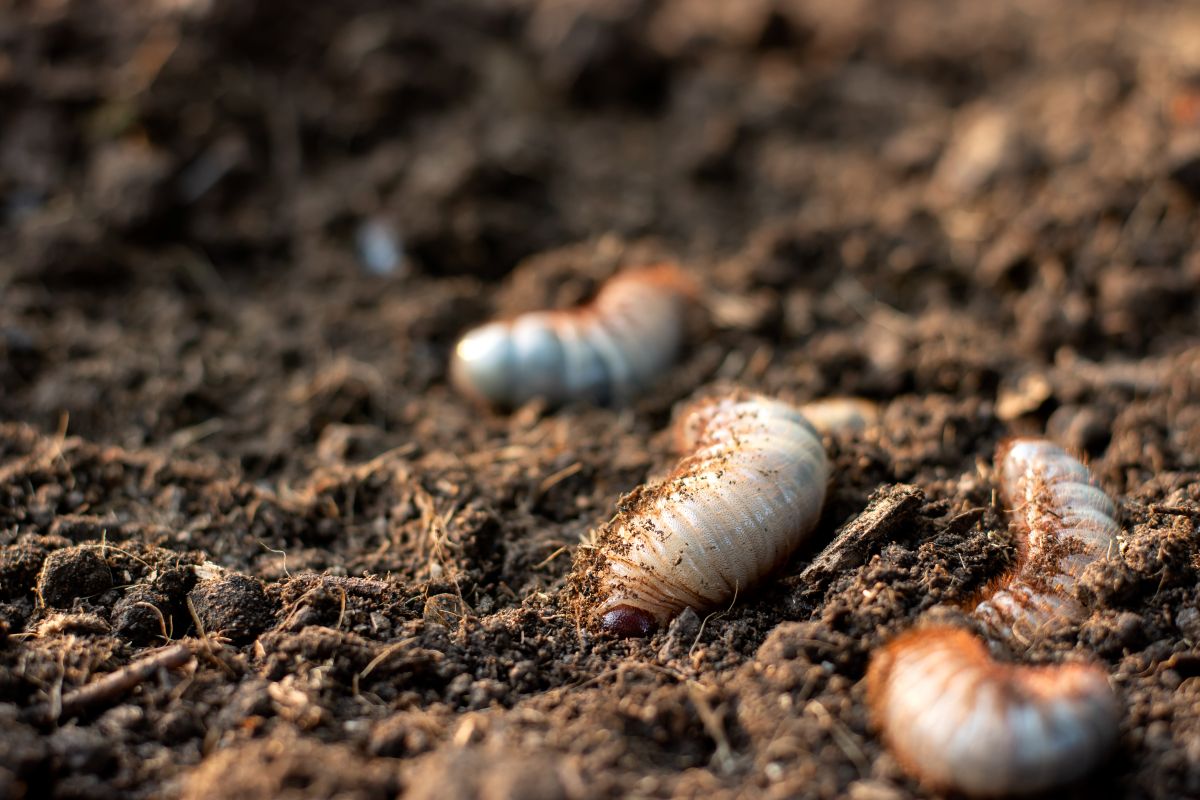Stop root-eating grubs before they devastate your lawn. Our preventative and curative treatments target active stages below the surface, preventing brown patches, spongy turf, and wildlife damage for season-long protection.
Grub Control in Suffolk County, NY
What Grubs Are—and Why They Wreck Long Island Lawns
“Grubs” are the larval stage of beetles—Japanese beetle, European chafer, and Oriental beetle are common across Suffolk County, NY. After adults lay eggs in summer, the larvae hatch and feed on lawn roots just below the surface. As they chew, turf loses its ability to take up water and nutrients, leading to brown, spongy patches, rapid decline during heat, and easy “roll-up” sod in severe cases. Skunks, raccoons, and birds often tear up the lawn hunting grubs, multiplying the damage.
Telltale Signs You Have a Grub Problem
- Irregular brown patches that worsen quickly, especially late summer into early fall
- Turf that peels back like a carpet due to root loss
- Wildlife digging (skunks, raccoons) or increased bird pecking
- Spongy footing or thin, wilted grass despite watering
While a spade test can reveal larvae, the most reliable approach is a professional inspection and, when needed, a preventative program before populations explode.
Our Two-Track Strategy: Preventative + Curative
We design grub control to match Suffolk County beetle cycles, soil type, irrigation, and turf species. The two essential tracks:
- Preventative Treatments (Best Value & Protection)
- Timing: Typically late spring through early summer, before peak egg hatch.
- Goal: Stop grubs before they begin destructive feeding by targeting early instars.
- Approach: We use season-long actives at label rates, applied with calibrated spreaders for even coverage. This method provides the highest reliability and dramatically lowers the odds of late-summer damage.
- Curative Treatments (Rescue When Damage Appears)
- Timing: When active feeding is already underway (late summer/early fall).
- Goal: Knock down existing larvae to halt damage as quickly as possible.
- Approach: Fast-acting products with proper watering-in to reach the root zone. We may pair with recovery steps such as spot seeding, light topdressing, and targeted nutrition to help turf rebound.
Watering-in matters: Most grub controls require irrigation after application to move actives into the root zone. We’ll give precise guidance based on the product used and same-day weather.
Integrated Lawn Recovery (So the Green Comes Back)
Stopping grubs is step one. We then help the lawn repair by restoring root mass and density:
- Starter or balanced fertilization to fuel root regrowth without surge top growth
- Core aeration (timed seasonally) to relieve compaction and improve oxygen/water flow
- Overseeding with region-matched cultivars to thicken thin areas and resist future stress
- Soil testing & pH balancing (lime where appropriate) to unlock nutrient availability and boost resilience
With this plan, most lawns show visible improvement in 2–4 weeks, with strong recovery over one full growing cycle.
Safety, Environmental Care & Product Stewardship
We use EPA-registered products and apply strictly according to label directions. Our techs are trained to target the root zone where grubs feed, minimizing off-target impact. You’ll receive clear re-entry guidance (typically once treated areas dry). We also advise cultural practices—proper mowing height, deep/infrequent watering, and annual overseeding—that reduce future infestations by maintaining dense, vigorous turf.
The Annual Grub Cycle in Suffolk County (Why Timing Is Everything)
- Late Spring/Early Summer: Adult beetles emerge and lay eggs.
- Mid–Late Summer: Eggs hatch; young grubs feed aggressively on roots.
- Fall: Grubs grow larger, continue feeding, then move deeper as temperatures drop.
- Winter: Dormant deeper in soil.
- Spring: Grubs move upward briefly to feed before pupating into adults.
Our scheduling aligns with these stages to prevent hatch or stop active feeders before they cause widespread root loss.
What to Expect on Service Day
- Inspection & Count: We assess damage patterns and, if needed, sample soil for larvae.
- Application: Even, calibrated coverage customized to your lawn’s square footage and risk profile.
- Watering Guidance: Exact irrigation instructions to activate the treatment.
- Recovery Plan: If damage is present, we outline overseeding/fertility steps to speed regrowth.
- Service Report: We leave written notes (and can email them) detailing products, timing, and next steps.
Pro Tips to Reduce Risk Next Year
- Mow higher (3–4") to encourage deep roots that tolerate minor feeding.
- Water deeply, less often to train roots downward; avoid chronic overwatering that invites beetles.
- Overseed annually to maintain density—thin lawns attract egg-laying adults.
- Keep thatch in check with periodic aeration; excessive thatch can harbor pests.
- Edge vigilance: Heat-stressed edges near pavement are susceptible; we often reinforce these zones.
Service Area
From our base in Holbrook, NY, we protect lawns throughout Suffolk County—including Ronkonkoma, Patchogue, Sayville, Bohemia, Holtsville, and surrounding communities. We know Long Island beetle patterns and how to time applications for maximum protection.
Why Country Estates Turf Care for Grub Control
- Local timing expertise matched to Long Island beetle cycles
- Preventative-first plans that save lawns (and budgets) from major repairs
- Curative options when damage appears, plus recovery to bring turf back fast
- Transparent service with clear instructions and responsive follow-up
Get a Free Quote
Don’t let grubs undo your hard-earned curb appeal. Protect your lawn with a timed, season-long grub control plan and rapid response if activity breaks through. Request your quote today or call (631) 473-2265—and keep your Suffolk County lawn green, dense, and grub-free from roots to blades.
